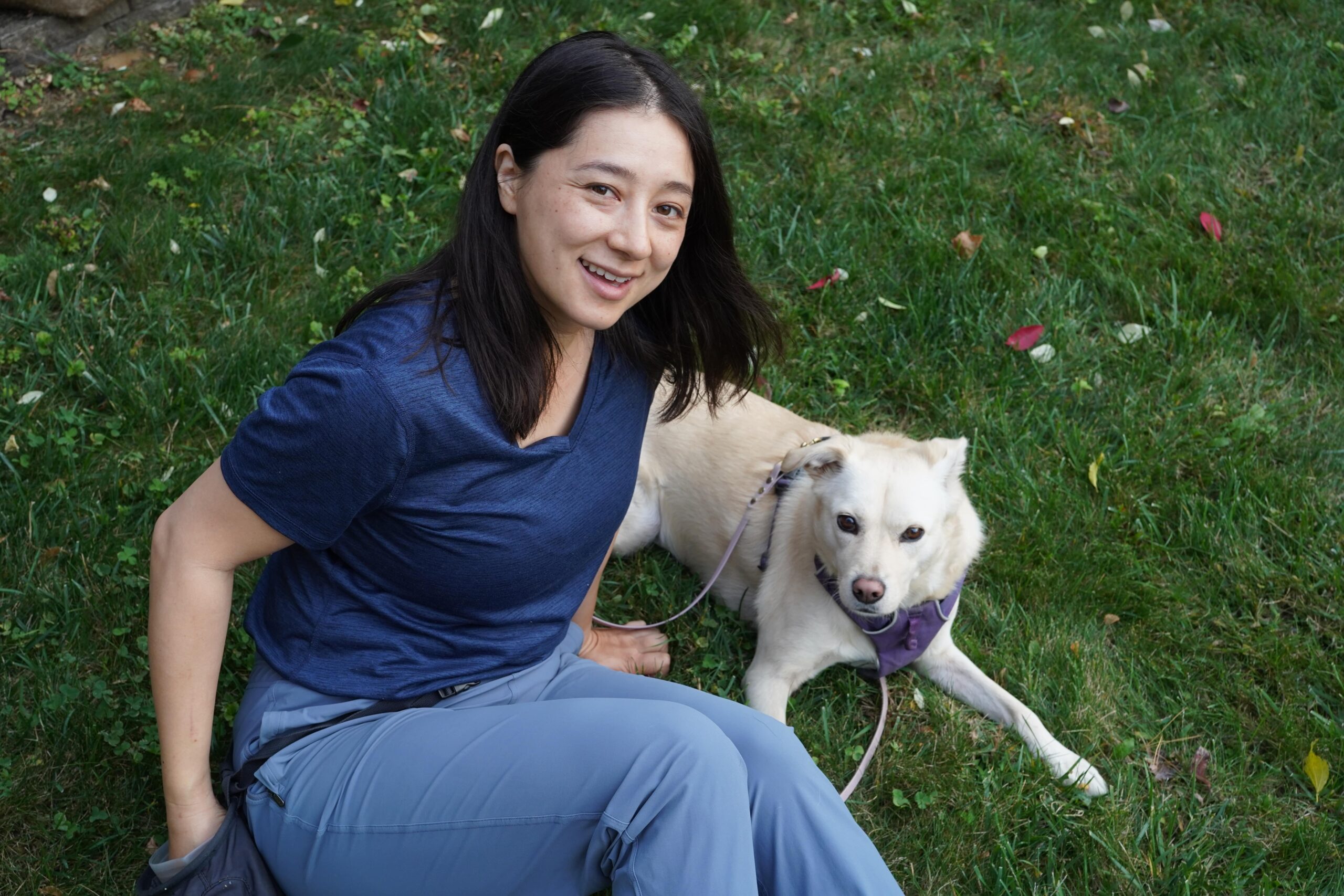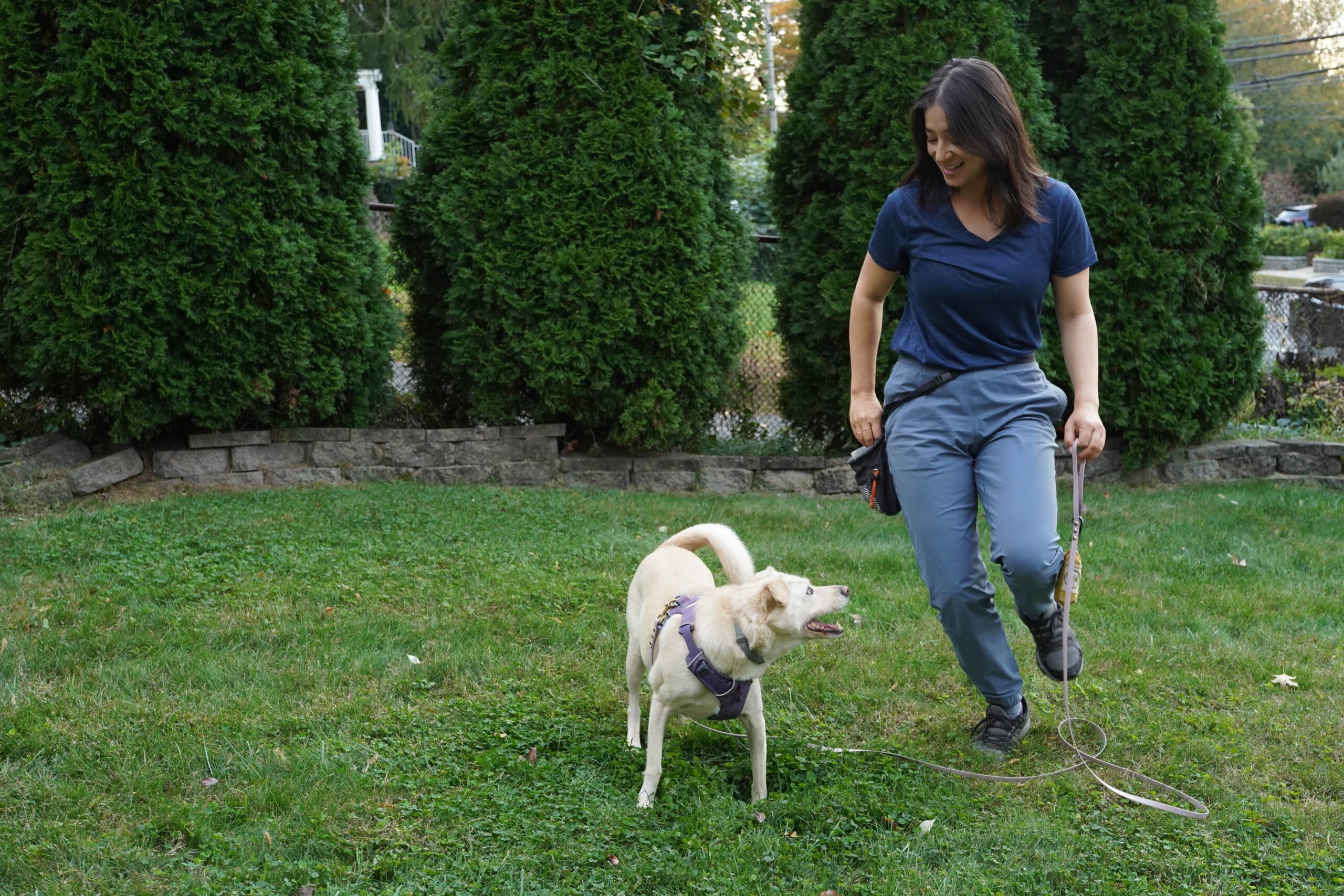This former arts educator says VSA gave her the skills and confidence to operate a successful dog training business

Today, Emily Ohara runs her own thriving dog walking and training business, dogtailsservices.com, working with clients who share her commitment to positive reinforcement methods. In this exclusive interview, she shares how the Victoria Stilwell Academy for Dog Training & Behavior (VSA) not only taught her to be an effective trainer but also gave her a framework for connecting with clients in ways that honor both dogs and their guardians.
What inspired you to transition from film education to becoming a dog walker and trainer?
In 2020 my life changed when my partner and I decided to adopt a dog from Korean K9 Rescue. It was a powerful experience, bringing in this emotional being who was traumatized from being on an airplane, being in a shelter, being in a new place with a different culture and language. I just fell in love with dog training and since I already loved teaching and working with people, I decided to take the chance and pursue it as a career.
What were your first steps?
I put my head down and decided I needed a lot of experience. So I became a dog walker and a volunteer at the local animal shelter. I wanted to surround myself with all different types of dog personalities, because dogs are very different from each other, with different backgrounds and quirks. That was really my foundation.
How did you find VSA?
When I decided to get more education and become certified, I put out feelers for recommendations. Victoria Stilwell Academy was one of two schools recommended to me. Between them, what really jumped out was VSA’s curriculum. They were demonstrating that they were thinking of me as a future dog trainer, and how they could best build me as an effective trainer to communicate with the human, not just the dog.
Tell us about your experience with the VSA Dog Trainer Course
The program was life changing. It was rigorous and very thoughtfully laid out. For example, they don’t teach you on Day One how to teach a dog to sit, which is maybe what other academies will do. Instead VSA laid out: here’s a history of dogs, here’s the history of dog training, and here is how dogs experience the world around them. VSA was teaching us to be empathetic and compassionate about these dogs, even prior to teaching them how to sit! Without that, teaching them is going to look very different. You can get easily frustrated. But if you know how dogs experience the world around them—then you’re ahead of the game.
How does that carry over to working with clients?
It was a beautiful blueprint for how I communicate with my own clients. I say “I know you have a bunch of cues you’d like to teach your dog, but first, let’s sit down and let me teach you how dogs view the world, how they smell the world, how they look at us.” When I do that, a light bulb goes off in their heads, and they’re like, oh my gosh, I never knew that. Once they are marinated in that compassion, they’re going to go into the training experience bringing that empathy with them, and they’re going to look at their dog differently. They’re going to empathize when the dog can’t hear them ask for something, and we can point that out—let’s look at the context here, why do you think they are unable to hear at this moment? I really appreciated the Victoria Stilwell Academy being able to demonstrate that for us as trainers, so that we can replicate that in our own work.
What was your biggest takeaway from the curriculum?
Dog training clients are usually looking for a solution. The academy really drilled into our heads that you can’t just go in and say, here, I can teach you a few skills. Instead, it’s: let me hear your problem, and here’s your immediate solution through management. Management is different than training. Now here’s what I can do for training, which is going to be long term, and we’re going to help change the behavioral reaction to whatever the dog may be struggling with. Then looking at the dog’s routine—how are they being enriched? It’s looking at the dog holistically. The whole curriculum reinforces that throughout.
Some trainers are very top-down hierarchical—their philosophy is to teach you immediate compliance—which is a shortcut and not helpful long term. VSA helped me understand that it’s not just teaching clients how to communicate with their dog for a sit. It’s teaching them how to have the dog pay attention to them, how to develop a relationship, because without the relationship, you have nothing.

Did the VSA Dog Trainer Course help you build confidence?
VSA helped me ground myself and focus on the type of interactions I want with my clients. I’m very transparent in the beginning: this is what I do. We’re going to focus on creating a relationship with your dog, on how to create a foundation of communication. We’re going to come to it with compassion and empathy. If they hear those words and want to join me on this journey, then I know we can work together. I never want to say, yes, I have the solution for you, when we’re not on the same page. I think it’s all due to Victoria Stilwell Academy’s mission and motto—it really permeates everything.
This program has really helped me come from a place where I’m saying you are your dog’s best dog trainer, because you live with your dog 24/7. I’m here to teach you so that you have this life skill and you’re not dependent on me. You can call upon me to freshen up when you need to or when a new challenge arises, but my goal is not to have you reliant on me. Going in, it means I’m responding, not reacting, to a client’s needs.
My clients have responded really well to that because they feel taken care of. They feel like I care, and I’ve heard them about their particular problem. It’s due to how VSA has modeled that with all their templates—how do you create a lesson plan? How do you create a plan that’s bigger than just that one day you’re with them?
What does your business look like today?
On a daily basis, my forefront is still dog walking, and then dog training comes after that. My dog training clients have come from a number of places including from dog walking clients and through word of mouth. I’ve also developed a wonderful relationship with my local pet store who cares about dogs just as much as I do. She has kindly given my information to patrons who may be looking for a positive reinforcement dog trainer. It’s been a very organic, natural network. This business has allowed me to meet so many wonderful people who want help understanding their dog and giving them the best life they can. I feel so lucky that I get to spend my time bringing out the best in dogs and training their humans in how to do the same.
What advice would you give to others considering this career path?
My initial advice for folks who are just starting out is to be around dogs as much as possible. That can look like volunteering at the local animal shelter, dog walking, grooming, pet sitting, or working at a dog training facility where you have the opportunity to observe and learn from other dog trainers. Second, is to understand that dog training is a lot about the people, not just the dogs. You need to know how to motivate the dog’s humans as they are the ones who are in their dog’s lives the most. Being genuine, actively listening, empathizing with their challenges, and making the lessons FUN for both the dog and the human, will create that trust and therefore buy-in.
What surprised you most about making this career change?
What surprised me was how much I was ready for owning my own business. It really took the pandemic and adopting my dog to reevaluate and realize it’s worth the risk. I have this confidence as my own business owner. Specifically with dog training, VSA is a beautiful example of seeing women of all ages doing what I’m doing, taking that chance. They look happy, they seem fulfilled. They’re doing it. Why can’t I? That was a lovely surprise—to see that there are a lot of us out there who are pursuing the same dream.
Learn more about preparing for a rewarding career as a dog trainer with VSA’s premier Dog Trainer Course.



